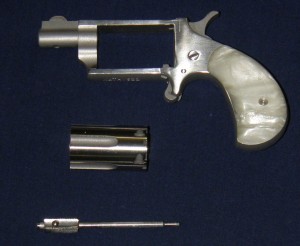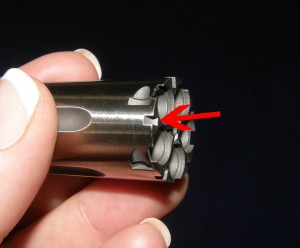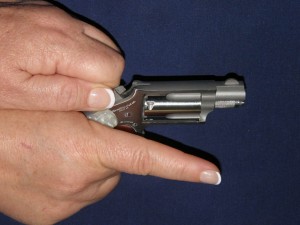Not long ago, there was an unintentional discharge from a gun in Colorado. Unintentional discharges are rare, but they aren’t as rare as we would like. In this case, a woman wanted to show her carry gun to a group of friends and co-workers while she was on a break at work. Her carry gun was an NAA Mini Revolver in .22 Magnum, like the one below.
Now, I’m not going to talk about whether an itsy-bitsy tiny little single-action gun chambered in an anemic caliber with a finicky manual of arms would make a good carry weapon (hint: no), but I will tell you that I own several and I love them. One of my favorites has pearlite grips, and I have a penchant for naming my handguns, so this one is—of course!—Mini Pearl. It’s a fun little range toy, a miniscule marvel of engineering. It’s about as dead simple as a firearm can get.
I understand the temptation to show off a beautiful little firearm like this. Really, I do. It’s cute. You can’t believe how small these things are in the palm of your hand.
(Oh, wait, I cheated. That’s not the already-tiny NAA Mini in .22 Magnum; that’s the even smaller .22 Short frame. Isn’t it charming?)
Adorable as they are, these little guns don’t belong in poorly-trained or untrained hands. They don’t belong in the hands of people who don’t practice with them. And even competent hands shouldn’t show off a carry gun unnecessarily, especially not at work.
Let me explain. An NAA Mini Revolver does not have a one-round-at-a-time loading gate like other single-action revolvers do, and its cylinder does not swing out on a hinge like the cylinders of most double-action revolvers. Instead, to unload the gun and make it safe to handle, you must remove its cylinder entirely from the frame.
In order to do that, you first rest the hammer in the half-cock position, and then press the tip of the cylinder pin.
After you have pulled the pin out …
… you can then remove the cylinder from the frame.

Removing the cylinder from the frame makes the gun safe to handle for dryfire and for showing others.
Pulling the hammer all the way back is sometimes called, “Cocking the hammer.” This makes the gun ready to fire when you press the trigger. With the cylinder removed, the gun can safely be handled even by novices, and it’s possible to dryfire it with the cylinder out, as you can see below.
Reloading this little gun requires you to reverse the process above, then add one more step after you put the cylinder back into the frame and pin it in place with the rod. To get the gun ready to carry, you hold the hammer slightly back, then gently spin the cylinder so that the hammer will line up with a notch at one of the halfway points between chambers.
Putting the hammer down on one of these in-between notches makes the revolver safe to carry.
Of course, it’s possible to make mistakes during this process. For example, if you pull the hammer too far back, it will lock to the rear—making the gun ready to fire with just a press of the unprotected trigger.
This isn’t a big deal, really. If it happens, you just need to safely lower the hammer before you finish what you’re doing. In order to do that, take a firm grip on the hammer.** Press the trigger to release the hammer from its catch point…
… and immediately straighten your trigger finger to get it off the trigger.
You then gently lower the hammer, keeping your finger far away from the trigger.*
Critical safety tip: you must immediately get your finger off the trigger, before you begin lowering the hammer. Failing to let go of the trigger is a bad mistake, sometimes a noisy one—and it very well could be what happened here. As long as your finger is holding the trigger back, the gun will fire if the hammer slips. Taking your finger off the trigger resets the gun’s internal safeties, which will keep the gun from firing even if the hammer slips out of your grip and falls more quickly than you can control.
If you were lowering the hammer gently by hand and then the hammer slipped out of your grip and fell forward while your finger was still on the trigger, the gun would fire. If the gun wasn’t pointed in a safe direction when that happened, you might injure yourself and other people. Even if the gun was pointed in a “safe” direction, if the thing you pointed it at was solid enough that the bullet bounced off it, things could get messy. A bouncing bullet usually isn’t quite as deadly as a direct hit, but it can still be plenty unpleasant for the punctured party. And in the right wrong set of circumstances, it could make you the star of some ugly news stories.
Unfortunately, handling a gun while distracted—as one might be when surrounded by a group of chattering friends at work—could easily lead you to make that series of small mistakes. In the right wrong set of circumstances, you could lose your job for that, and the authorities could even decide to press charges. (Police reports in .pdf format here.)***
So what did we learn, here?
Start with the idea that people make mistakes. Now add a simple gun with a finicky manual of arms. And one more key ingredient: it was being handled (unnecessarily) by someone who was surrounded by a group of chattering friends. Kablowie. It’s a recipe for a noisy and expensive mistake.
Of course, we all make mistakes sometimes. This is true no matter what type of firearm you choose to carry. To err is human, and nobody’s perfect. The timing of this incident really stunk for the gun rights movement, but the fact of it stunk even more for the women who got hurt. Compassion never goes out of style.
So here are the lessons as I see them.
- When you decide on a carry gun, choose one with a simple manual of arms.
- Remember that no matter how “simple” your gun is, you still need to learn how to handle it safely. You must become so well-trained at handling it safely that you can stay safe (and keep the people around you safe) even when you’re distracted.
- Don’t handle your carry gun unnecessarily. With very few exceptions, “showing co-workers how my gun works” is unnecessary handling. When you want to show your firearm to a friend, invite her to come with you to the range, where you can show her how it really works … in an environment where gunfire is expected, and where there is a safe, reliable backstop.
These rules — learn to handle your carry gun safely, never handle it unnecessarily or while distracted — always apply no matter what gun you choose to carry. As the inimitable Tamara is apt to say: “Stop touching it!”
* Note: in the last two pictures, I flipped the images over, which is why the shadows look weird and the printing is odd. It was necessary because I could not photograph the angle I wanted with the gun pointed in a safe direction with a good backstop, so I chose to take the pictures from a weird angle and flip the images later. Safety first!
** Edited to remove a goof. (See comments.)
*** Edited to add the obvious: I do not know what happened in this particular case. The above is simply one potential explanation for how a discharge such as the one described in the news and police reports could occur using this type of firearrm. There are other possibilities, including ones that do not involve mishandling the gun.

















4 Responses to Lessons from a mistake